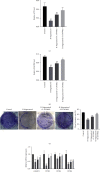Arisaema heterophyllum Blume Monomer Stigmasterol Targets PPAR γ and Inhibits the Viability and Tumorigenicity of Lung Adenocarcinoma Cells NCI-H1975
- PMID: 35911149
- PMCID: PMC9328949
- DOI: 10.1155/2022/5377690
Arisaema heterophyllum Blume Monomer Stigmasterol Targets PPAR γ and Inhibits the Viability and Tumorigenicity of Lung Adenocarcinoma Cells NCI-H1975
Abstract
To clarify the regulatory effect and molecular mechanism of Arisaema heterophyllum Blume (AhBl) monomer stigmasterol on lung adenocarcinoma in human lung adenocarcinoma cells NCI-H1975 cultured in vitro and in nude mice. Oil red O staining, free fatty acid detection, adenosine triphosphate (ATP), and NADPH were applied to elucidate the regulatory effect of stigmasterol on the energy metabolism of NCI-H1975 cells. Simultaneously, colony formation assay and nude mouse tumorigenesis were performed to clarify the underlying mechanisms of stigmasterol on the proliferation and tumorigenesis of NCI-H1975 cells. Furthermore, peroxisome proliferator-activated receptor gamma (PPARγ) inhibitor GW9662 was supplemented to determine the expression changes of cyclins to clarify the regulation mechanism of stigmasterol. The results revealed that stigmasterol administration markedly inhibited the viability but promoted lipid deposition of NCI-H1975 cells. Meanwhile, the reduction of cell energy metabolism affected cell proliferation and colony formation. qPCR and western blot assays indicated that stigmasterol played a role in regulating the expression of cyclins and PPARγ signaling pathway proteins. Nude mouse tumorigenesis suggested that tumor size and weight in the stigmasterol-treated group were apparently lower as compared with the control group. Tumor tissue cells developed varying degrees of degeneration and large areas of ischemic necrosis presented in the central and peripheral cells. Immunohistochemistry results revealed that Ki67 expression in the stigmasterol group was substantially inhibited, while PPARγ expression was greatly elevated as compared with the control. GW9662 could mediate the inhibitory effect of stigmasterol on NCI-H1975 cells. The current study demonstrated that stigmasterol targeted PPARγ and inhibited the viability and tumorigenicity of lung adenocarcinoma cells NCI-H1975.
Copyright © 2022 Na Song et al.
Conflict of interest statement
The authors declare that they have no conflicts of interest.
Figures





Similar articles
-
Advances in Stigmasterol on its anti-tumor effect and mechanism of action.Front Oncol. 2022 Dec 12;12:1101289. doi: 10.3389/fonc.2022.1101289. eCollection 2022. Front Oncol. 2022. PMID: 36578938 Free PMC article. Review.
-
Thermal treatment decreases resistance to osimertinib in non-small cell lung cancer through the EGFR/PI3K/AKT pathway.Neoplasma. 2021 May;68(3):535-545. doi: 10.4149/neo_2021_200506N489. Epub 2021 Mar 17. Neoplasma. 2021. PMID: 33724860
-
Agglutinin isolated from Arisema heterophyllum Blume induces apoptosis and autophagy in A549 cells through inhibiting PI3K/Akt pathway and inducing ER stress.Chin J Nat Med. 2016 Nov;14(11):856-864. doi: 10.1016/S1875-5364(16)30102-9. Chin J Nat Med. 2016. PMID: 27914529
-
The reverse effect of X-ray irradiation on acquired gefitinib resistance in non-small cell lung cancer cell line NCI-H1975 in vitro.J Mol Histol. 2014 Dec;45(6):641-52. doi: 10.1007/s10735-014-9583-2. Epub 2014 Jul 10. J Mol Histol. 2014. PMID: 25008024
-
Characterization of osimertinib (AZD9291)-resistant non-small cell lung cancer NCI-H1975/OSIR cell line.Oncotarget. 2016 Dec 6;7(49):81598-81610. doi: 10.18632/oncotarget.13150. Oncotarget. 2016. PMID: 27835594 Free PMC article.
Cited by
-
Advances in Stigmasterol on its anti-tumor effect and mechanism of action.Front Oncol. 2022 Dec 12;12:1101289. doi: 10.3389/fonc.2022.1101289. eCollection 2022. Front Oncol. 2022. PMID: 36578938 Free PMC article. Review.
-
Stigmasterol: An Enigmatic Plant Stress Sterol with Versatile Functions.Int J Mol Sci. 2024 Jul 25;25(15):8122. doi: 10.3390/ijms25158122. Int J Mol Sci. 2024. PMID: 39125690 Free PMC article. Review.
-
Research Progress on the Therapeutic Mechanisms of Stigmasterol for Multiple Diseases.Molecules. 2025 Apr 23;30(9):1874. doi: 10.3390/molecules30091874. Molecules. 2025. PMID: 40363681 Free PMC article. Review.
References
LinkOut - more resources
Full Text Sources

